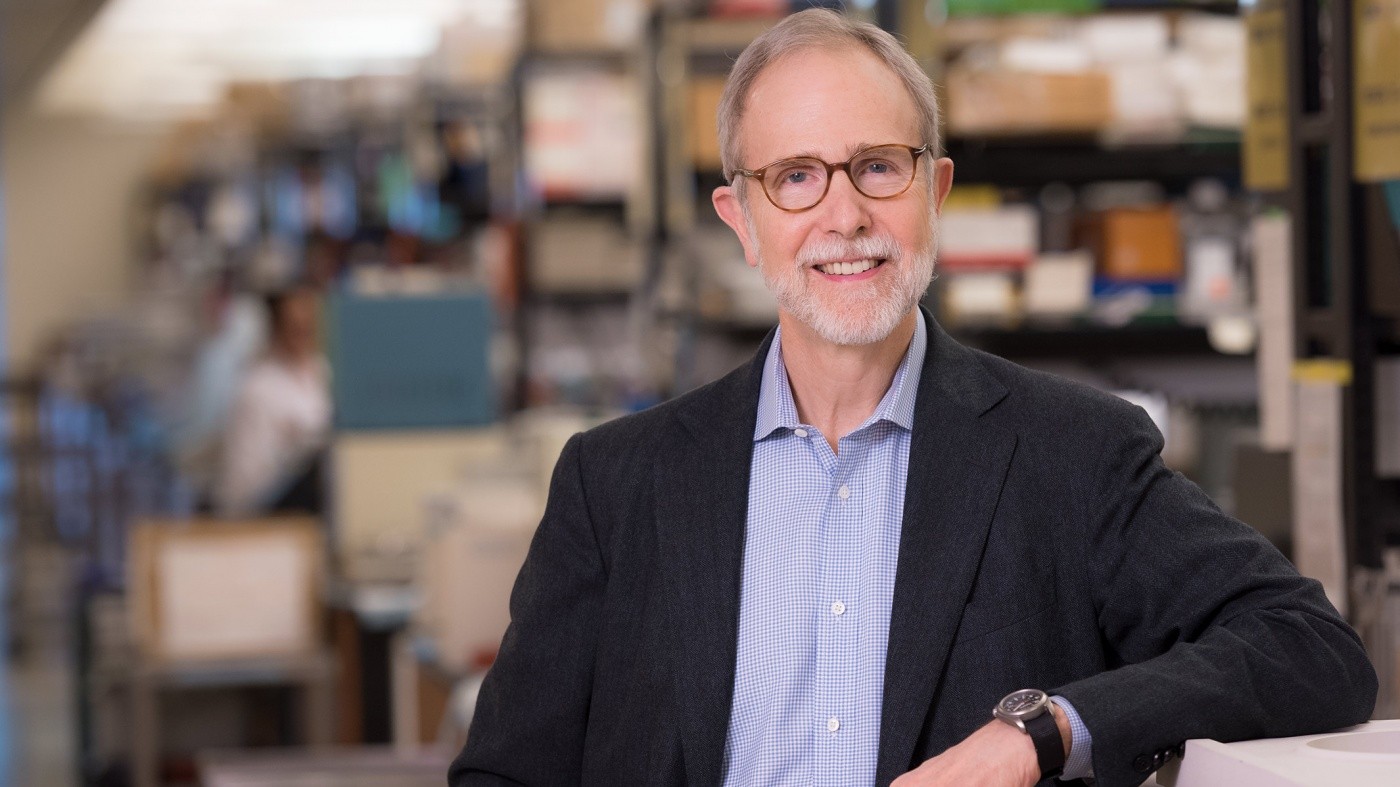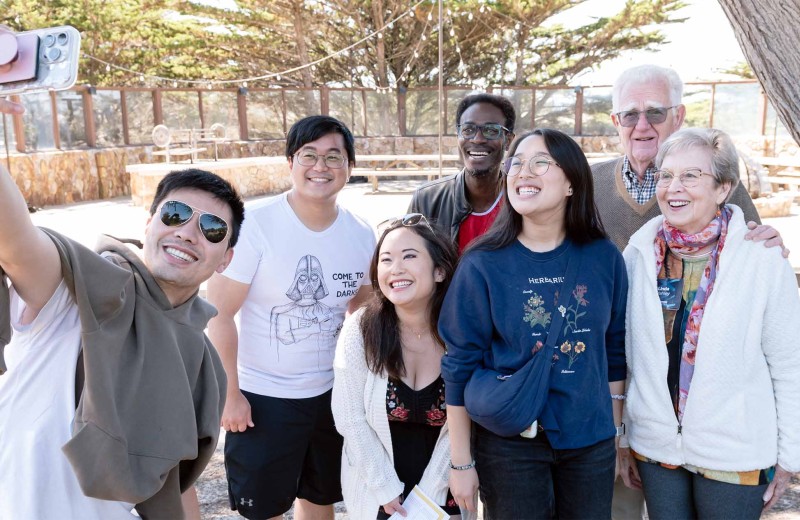Gladstone NOW: The Campaign Join Us on the Journey✕

Sandy Williams led the institution through a critical period in its history. [Photo: Gladstone Institutes]
R. Sanders Williams, MD, known as Sandy to his colleagues and friends, has been president of the Gladstone Institutes since 2010. On December 31, 2017, he will be stepping down and passing the baton to Deepak Srivastava, MD. Williams looks back at the goals and challenges that were paramount at Gladstone over the past 8 years.
When Williams took over the Gladstone presidency in 2010, he found a solid foundation built under the direction of founding President Robert W. Mahley, MD, PhD. Gladstone was, is, and always should be an institution that values excellence in science—and science with a purpose—and where researchers and staff share a strong work ethic and sense of mission.
However, the same year, the entire country was emerging from a recession. Gladstone faced declining earnings on its financial reserves held by the trust, plus large financial obligations to pay for and operate its splendid new building. In addition, overall research funding from the National Institutes of Health was declining.
Several private scientific institutions succumbed to this perfect storm of financial pressures and closed, but Williams resolved to do everything necessary for Gladstone not only to survive, but to prosper.
“My role was to guide Gladstone through a necessary transition, between the leadership of a visionary founder who imbued the institution with many admirable traditions and the next phase of its development,” said Williams. “I tried to help the organization successfully adapt to a whole new world of exciting opportunities emerging in science, while confronting unprecedented financial challenges.”
Prior to joining Gladstone, Williams was dean of the Duke University School of Medicine and vice chancellor for academic affairs at Duke University Medical Center. He also served on various public and private company boards in the life sciences. As a result, he brought to Gladstone broad experience spanning both academic research and the biopharmaceutical industry.
“Sandy came in at an important time in Gladstone’s history,” explained Andy Garb, Gladstone trustee. “He was willing to question our existing way of doing science, just at a time when we needed to reevaluate our method of operation. Sandy shepherded the institution through this period of financial difficulty and even managed to make Gladstone grow, which is an impressive accomplishment.”
In the midst of changes in academic sciences, biotechnology and pharmaceutical industries were also evolving. Gladstone was determined to keep pace and bring increasing credence to the motto of “Science Overcoming Disease” proposed by Williams.
“Under Sandy’s leadership, we chose to purposefully recognize that the landscape had shifted and respond by finding creative ways to advance our disease-related discoveries closer to clinical trials,” said Deepak Srivastava, MD, who will replace Williams as Gladstone president in 2018. “Thanks to his experience and his unique perspective, we are now on extremely strong footing, both scientifically and financially.”
The road to increasing scientific progress combined with financial stability wasn’t necessarily an easy one, and Williams faced important challenges.
“The biggest puzzle was optimizing the balance between traditional practices and organizational innovation,” said Williams. “We had to protect the best features of Gladstone’s past while driving hard into the future and taking some risks. Change is hard, and preparing the organization to change was both a great challenge and a great opportunity. I think we succeeded in getting people excited about new possibilities and moving towards a unified vision of Gladstone’s future.”
Entrepreneurial Spirit
In recent years, the tools available for life science researchers have advanced at spectacular speed, and Gladstone pioneered several methods—consider cellular reprogramming and bioinformatics—that transcend any single disease. To respond to this change and improve the way science at Gladstone is conducted, Williams decided to explore different organizational structures, rather than focus solely on the three traditional disease areas.
From this exploration was born the Convergence Zone. Its mission is to encourage collaboration between experts in different fields to bring novel platforms and approaches to science and medicine.
“We’ve moved from an era where scientists could work individually and command, in one laboratory, everything they needed, to a world that’s much more interactive and where, to move towards a discovery, you need technologies that one lab can’t really master or afford on its own,” explained Williams. “So, it’s now important to create an environment where scientists can interact with other labs or core facilities, and work together to make more impactful breakthroughs.”
Williams also leveraged his commercial and international experience to encourage purposeful translation of scientific discoveries and boost entrepreneurship. He helped increase interaction between Gladstone and venture capitalists, as well as biotech and pharmaceutical companies, some of which led to partnerships or spin-off companies.
“One of the big challenges throughout the scientific and healthcare community is to take discoveries from academia and advance them towards medicine,” said Gladstone Trustee Nick Simon. “Sandy had an idea about how to fill that gap, and used his network to get the necessary infrastructure in place to make it happen. He’s a great visionary, and he’s been a terrific leader.”
In line with this same vision, Williams set up BioFulcrum, an entrepreneurial enterprise within Gladstone aimed to accelerate the discovery of cures for major unsolved diseases by converging scientists, multiple non-profit institutions, and industry partners. The biopharmaceutical company Tenaya Therapeutics Inc. emerged from this initiative.
“Through BioFulcrum, Sandy came up with a way to take high-quality, meritorious research and help bring it to the patients in a much shorter time, and in a much more efficient way than traditional academic research would have allowed,” said Garb. “Tenaya is a perfect example in the field of heart failure, where commercial interests materialized far sooner than we would have ever expected.”
To diversify revenue sources even further, Williams increased Gladstone’s prowess in philanthropy by helping launch the Gladstone Foundation, with a board of directors distinct from the trustees. He was pleased when Bill Price agreed to become the founding chair of the Foundation.
“We knew that with our existing resources, we were unable to fund all the great research and ideas the scientists were coming up with,” said Price, now a Gladstone trustee. “We created the Foundation as a way to broaden awareness of Gladstone and ultimately get more people involved in the funding of our research.”
Most Memorable Moment
One of Williams’s most memorable moments as president was his recent experience at Gladstone’s first graduate student retreat.
“I was invited to the retreat, where I saw a group of students reveling in the adventure of science, and acting on their own initiative to have scientific dialogue,” he recalled. “To me, that speaks to the kind of organization I want to be part of, and it was satisfying to know that it was happening at Gladstone. I was very proud of the graduate students on that day.”
Williams was instrumental in the creation of the graduate student organization, called Gladstone GO. The idea originated in a town hall he held with the students in 2016 to listen to their unique needs and determine how he could improve their learning experience.
Following that meeting, the trainees expressed a desire to create a group at Gladstone that would increase scientific and personal collaboration among students and foster a greater sense of community.
“Sandy was immediately supportive,” said Oriane Matthys, graduate student and chair of Gladstone GO. “He asked what we envisioned, what we needed, and offered administrative support to get us started. Gladstone GO has had a tremendous impact on our student life, and we truly appreciate Sandy’s encouragement and availability in helping us launch it.”
A Look Back
Williams joined Gladstone due to the excellent quality of the science. He was also drawn to the exciting environment provided by the Mission Bay location. And, he liked the independent research institution model.
“In comparison to the large universities and academic medical centers, I found the Gladstone model as an independent research enterprise very appealing,” said Williams. “Smaller scale, greater focus, independent decision-making, and a unified mission can become powerful competitive advantages.”
He also singled out Srivastava as being a key factor in his decision. They met more than 20 years ago at the University of Texas Southwestern Medical Center.
“I found it significant that Deepak came to Gladstone when he could have gone anywhere he wanted,” recalled Williams. “He chose this institution, and that was strong evidence to me of the special nature of this place. My longstanding relationship with Deepak now makes it particularly gratifying to hand over the reins to him.”
The Future Awaits
Williams believes deeply that a good leader should accomplish two primary tasks while in office: to articulate and ensure that important goals for the organization are achieved; and to strongly position the organization for the leader who follows.
“At Gladstone, I’m happy that both of these key leadership tasks have been achieved,” said Williams. “I’ve been especially attentive to succession planning—a vital responsibility of leadership—almost from the day I arrived. We are all very fortunate that Deepak will become the new president, and I’m personally delighted that he was ready, willing, and more than able to lead Gladstone to even higher levels of achievement.”
“Having seen quite a few transitions, the seamless way that Sandy is empowering and handing off responsibility to Deepak is really impressive,” said Price. “I believe it bodes very well for Deepak’s future success.”
As the end of his term approaches, Williams is excited for change, which he’s always embraced.
He will be splitting his time into several parts come January. He will maintain a set of Gladstone-related activities and serve on the boards of public and private companies in the Bay Area and elsewhere. He also plans to renew ties with Duke University, although specific details remain to be set.
“I’ll also have greater opportunity to be together with my three young grandchildren,” said Williams. “They live in different parts of the country, so my wife and I will be traveling about quite a bit in the coming year.”
When asked about his overall experience at Gladstone, Williams said: “It’s been exactly the adventure I was hoping for.”
“I was looking to immerse myself among brilliant scientists, to bask in the glow of their genius and accomplishments, and to do my best to help structure the environment and provide the resources to move the science to an even higher level,” he added. “Happily, I think that’s happened.”
Want to Join the Team?
Our people are our most important asset. We offer a wide array of career opportunities both in our administrative offices and in our labs.
Explore CareersFrom Mentorship to Legacy: Creating Opportunity for Early Career Scientists
From Mentorship to Legacy: Creating Opportunity for Early Career Scientists
Robert and Linda Mahley’s commitment to trainee development continues through Gladstone’s annual Career Advancement Awards.
Graduate Students and Postdocs HistoryGladstone Mourns the Loss of Founding Trustee Richard D. Jones
Gladstone Mourns the Loss of Founding Trustee Richard D. Jones
Jones lent Gladstone his time and expertise for nearly 50 years.
History Institutional NewsRemembering Bill Rutter, a Biotech Visionary and Champion of Gladstone
Remembering Bill Rutter, a Biotech Visionary and Champion of Gladstone
William J. Rutter, PhD, was a pioneering force in biomedicine whose vision shaped San Francisco’s Mission Bay neighborhood into a hub for innovation and discovery.
History Profile



